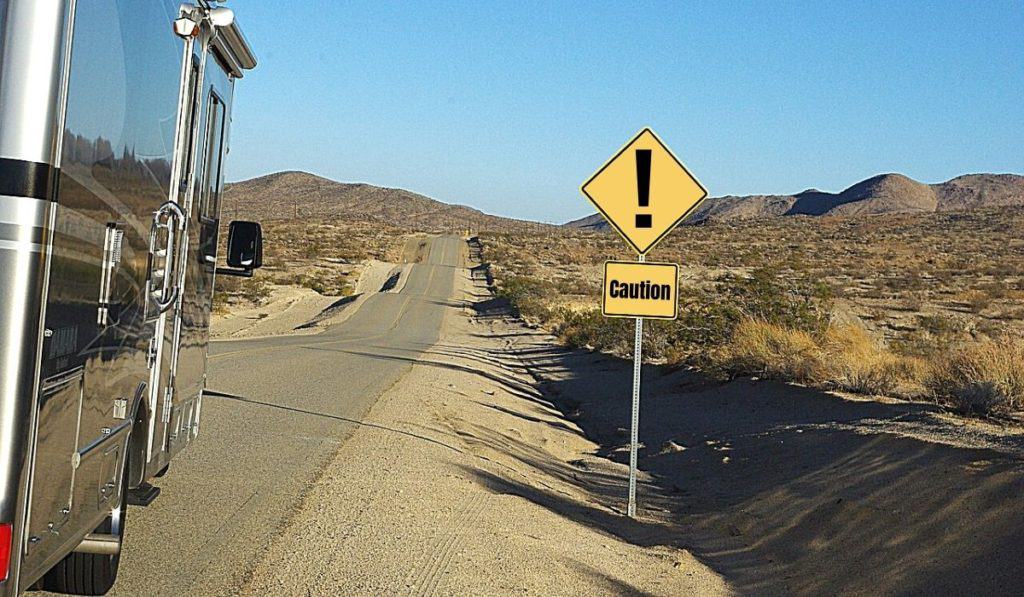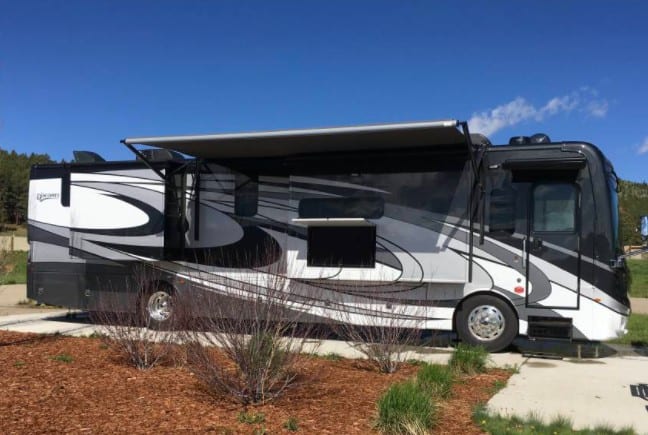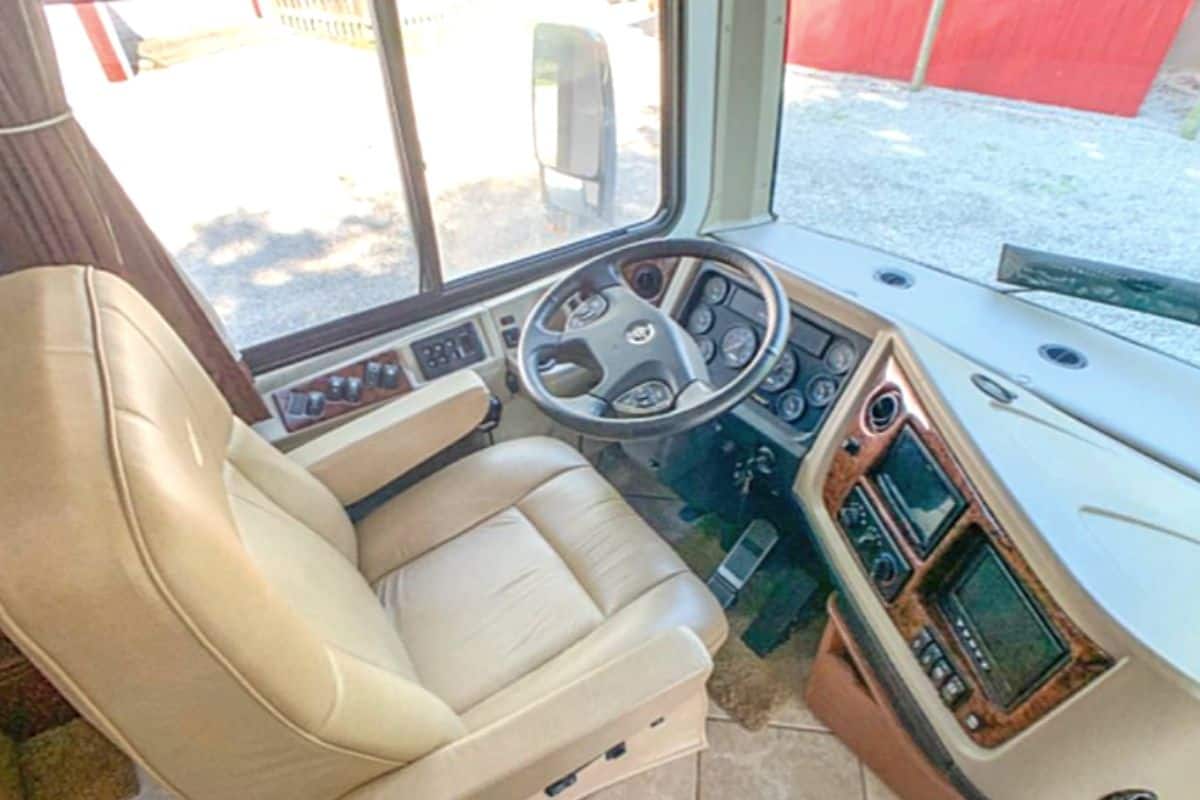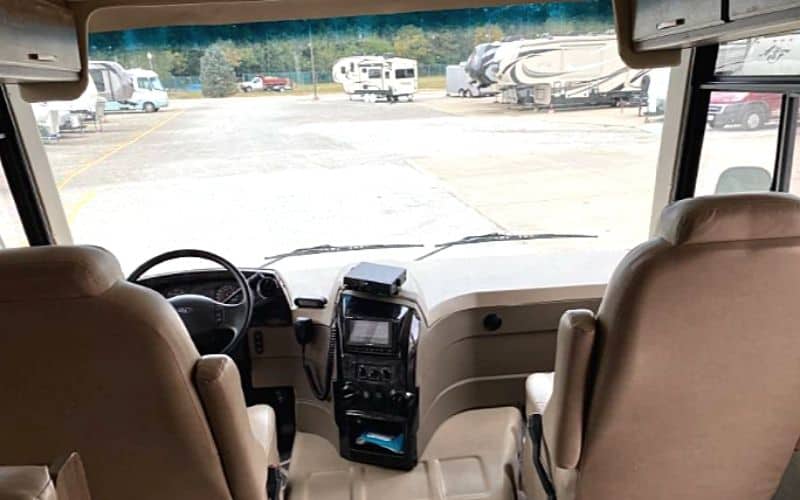Beginner RVers are often intimidated and nervous about driving a motorhome for the first time.
As they assume it will be difficult, challenging, and perhaps even scary.
And this is especially true for Class A RVs, as they are the largest and longest type of motorhomes out there, with lengths often longer than 35+ feet and gross vehicle weight ratings of well over 10,000 pounds.
But is it hard to drive a Class A RV?
While driving a Class A RV does take some getting used to due to its larger size.
Driving a Class A RV is not hard or difficult, once you’ve adjusted your driving to accommodate for its longer length and heavier weight.
But if you’re planning on driving a Class A RV or motorhome for the first time, there are definitely some things you need to know beforehand.
In order to ensure it goes as smoothly and trouble-free as possible, which is what we will be discussing in the rest of this article.
What is it Like to Drive a Class A Motorhome?
While you might think that driving a Class A motorhome would feel completely different and be nothing like your used to, due to its larger size.
In actuality, driving a Class A motorhome is very similar, to driving any other passenger vehicle, as everything is located in exactly the same place, with the gas pedal on the right and the brake on the left.
The biggest difference, however, and the thing you will notice the most when driving a Class A RV is the size of the vehicle itself, as everything is much larger on a Class A motorhome including its length, width, height, and weight.
But once you’re used to the larger size of a Class A motorhome and have adjusted your driving to accommodate for this larger size, it’s really pretty much like driving any other vehicle on the road.
Average Specs: Class A Motorhome vs Passenger Vehicle
| Specs | Class A Motorhome | Passenger Vehicle |
| Length | 32 Feet to 40 Feet | 15 Feet to 20 Feet |
| Width | 7 Feet 11 Inches to 8 Feet 5 Inches | 6 Feet to 6 Feet 6 Inches |
| Height | 13 Feet to 14 Feet | 5 Feet to 7 Feet |
| Weight | 13,000 Pounds to 30,000 Pounds | 2,000 Pounds to 6,000 Pounds |
Tips for Driving a Class A Motorhome for the First Time
When driving a Class A motorhome or any motorhome for that matter, there are three main buckets every driving tip falls into, which include PMI (Preventive Maintenace Inspection) tips, driving tips, and mindset tips.
So to help make it more clear and easier to understand, we’ve separated all of our Class A motorhome driving tips into these three main categories.
PMI (Preventive Maintenance Inspection) Tips
Before you ever get behind the wheel of your Class A motorhome and put it into drive, it’s important to go through the below exterior and interior PMI checklist in order to avoid accidents and prevent damage to the RV.
Exterior
- Leveling Jacks: Ensure all leveling jacks are up and stored by visually inspecting each jack.
- No Obstructions: Make sure there is nothing on the ground near or underneath the coach.
- Disconnect: Make sure the water, electric, and sewer lines are disconnected from the RV.
- Bay Doors: Check all bay doors to ensure they are shut and locked.
- Top Side Mirror: Make sure the top side mirrors are set properly by ensuring the inside 1/4 of the top mirror is showing your motorhomes sidewall and the remaining 3/4 is showing off the couch. And that the bottom 1/3 is showing the ground and the top 2/3 is showing up and back.
- Bottom Side Mirror: Make sure your bottom side mirror or convex mirror is set so that you can see down the side of the motorhome all the way to the back of the coach.
- Tires: Check to make sure all tires a properly inflated and do not appear low or flat.
Interior
- Cabinet Doors and Drawers: Ensure all cabinet doors and drawers are tightly shut and secure.
- Fridge and Freezer: Make sure the fridge and freezer doors are locked and that everything inside the fridge is wedged in place and secure by using a refrigerator bar like this 34-inch Camco double refrigerator bar on Amazon.
- Slide Locks: If your Class A motorhome is equipped with slide locks make sure they are in the locked position.
- Signals and Lights: Check to ensure that all lights and turn signals come on and are working properly.
- Driver Seat and Steering Wheel: Make sure the seat and steering wheel are in a comfortable position and at the right angle.
- Emergency Brake: Release the emergency brake, which should always be engaged when your Class A RV is parked.

Class A Motorhome Driving Tips
These tips will help you drive your Class A motorhome like a pro, even when you’re just starting out.
Know Your Height
Make sure you know the height of your Class A motorhome, which is usually between 13 and 14 feet, and watch for low clearance signs and warnings.
As there are many overpasses and bridges throughout the US that will not be tall enough for your Class A RV to pass under.
Use an RV Specific GPS
While having a GPS is a no-brainer no matter what you’re traveling in.
Having an RV-specific GPS unit can be a big help and a real lifesaver when traveling in an RV.
As an RV-specific GPS will ensure the route you’ve selected is safe for RV travel.
However, it’s worth mentioning that you still need to use common sense even if you have an RV-specific GPS.
And make sure you’re paying attention to low clearance signs and warnings and not just blindly trusting and following the RV GPS unit.
If your looking for an RV-specific GPS unit, one of our favorites is the Garmin RV 890, which you can see on Amazon by clicking here.
Understand Off Tracking and Rear Overhang
Off-Tracking
Off-tracking describes when a vehicle’s front wheels follow a different path than its rear wheels while turning.
And while all vehicles off-track to a certain extent including small passenger vehicles, knowing and understanding off-tracking becomes extremely important when driving a Class A motorhome, due to its much longer wheelbase, which makes off-tracking much more pronounced while turning.
So when driving a Class A RV it’s important that you adjust and accounts for its pronounced off-tracking by taking all turns and especially tight turns wide, to allow the rear of the coach to clear all obstructions on the inside of the turn.
To see a visual representation of this, make sure you check out the above YouTube video, as it does an excellent job of visually demonstrating off-tracking.
Rear Overhang
All motorhomes have some level of rear overhang, which is the portion of the motorhome that extends beyond the rear wheels of the coach.
And because of this, it’s important to understand how to handle the rear overhang on a motorhome.
The main thing to remember though is the rear overhang of a motorhome will swing out in the opposite direction of the way your turning.
And the larger the overhang and tighter your turn radius the more pronounced the rear overhang swing will be.
So when driving a Class A motorhome you need to make sure that you account for the rear overhang swing and give yourself plenty of room, especially if you parked close to obstructions such as other parked vehicles, curbs, or signs.
For an excellent visual representation of the rear overhang swing, again make sure you check out the above YouTube video.
Follow the “10 Second” Rule
The “10 Second” rule is a good way to ensure you’re leaving enough room to safely stop when driving a Class A motorhome.
As it will take substantially longer to stop a Class A motorhome, due to its larger size and heavier weight.
The “10 Second” rule states you should always leave 10 seconds of space between you and the car in front of you.
So to see if you’re leaving enough room between you and the car in front of you, mark when the car in front of you passes a particular sign along the road and make sure you can count to 10 before you pass that same sign.
Stay in the Right Lane
When driving a Class A motorhome, it’s best to stick to the right lane.
As you will be driving much slower compared to the traffic around you.
But driving in the right lane also serves a particular purpose as well, as it allows you access to the right shoulder in case another vehicle were to come into your lane or if there was an obstruction in the road.
Always be Alert, Proactive, and Vigilant
Being alert, proactive, and vigilant is important while driving, no matter what type of vehicle you’re driving but when driving a Class A motorhome, this takes on much more significance, due to the size and weight of a Class A motorhome.
So while driving a Class A RV, you want to make sure you’re constantly scanning your surroundings, by not only looking as far out in front of you as possible but also constantly checking your side mirrors and cameras as well.
So you can react proactively and defensively to any dangerous or emergency situation while driving a Class A motorhome.
Always Have a Plan and an Escape Route
Due to the larger size and heavier weight of a Class A motorhome, it’s important you always have a plan and escape route in mind.
As a Class A RV will not be as forgiving in an emergency braking or turning situation compared to a small passenger vehicle.
So while driving a Class A motorhome, always makes sure you’re running what-if scenarios in your mind and have an escape route planned out in case that what-it scenario was to occur.
For example, if a car were to cut you off while driving, make sure you’re ready for this scenario before it ever occurs so that you can react calmly and appropriately to the situation.
In essence, you should always be trying to expect the unexpected while driving a Class A motorhome, in order to avoid accidents and potentially dangerous driving situations.
Be Mindful of Blind Spots
When driving a Class A motorhome there are two main blind spots that you need to be mindful of, including the area directly in front of the RV underneath the windshield and the area directly under the passenger side mirror.
As you cannot see either of these areas while sitting in the driver seat of a Class A motorhome.
So when maneuvering and changing lanes in a Class A motorhome, you always need to make sure these areas are clear, in order to avoid a collision or accident.
Know How to Handle Mountain Passes
When climbing and going down mountain passes in a Class A motorhome extra caution and care need to be given, due to the heavyweight of a Class A RV.
So when crossing over mountain passes or any extended steep grade remember these below helpful tips.
- Use tow-haul mode, as this will shift your RV into a lower gear to provide extra torque while climbing and provide engine braking while descending.
- Be prepared to go slow while going uphill, especially in a gas Class A motorhome, so you don’t overwork or overheat the engine.
- Turn your hazard lights on, so traffic around you is aware of your slower speed.
- Once you’ve reached the crest of the hill, slow down even further, to provide yourself some extra cushion for speed when you start going downhill.
- When going downhill, hitting your brakes will usually cause the engine to downshift, which will provide more engine braking and require you to use your brakes less.
- When going downhill, try to only apply the brakes in 15 or 20-second bursts to help ensure your brakes don’t overheat.
Practice, Practice, Practice
One of the best things you can do to feel more comfortable and confident behind the wheel of a Class A motorhome is to practice, practice, practice.
So once you’ve purchased your Class A RV, take it to a large open empty parking lot, to practice turning and braking.
So you can learn how to maneuver and handle your Class A motorhome in a wide-open low-stress environment.
Consider Taking an RV Driving Class
When you first got your driver’s license and started driving, you more than likely took some sort of driver education class to learn proper driving techniques and to help you feel more comfortable and confident behind the wheel.
So if you’re feeling particularly uncomfortable and unsure of yourself while driving a Class A motorhome, you might want to consider taking an RV driving class.
As an RV driving class will teach you proper techniques for driving a Class A motorhome and help you feel more comfortable and confident behind the wheel.
If you’re looking for an RV driving school, you should definitely check out rvschool.com, which is one of the biggest RV driving schools in the country and has locations all over the US.

Class A Motorhome Mindset Tips
Now that we’ve covered both PMI tips and driving tips, the last set of tips helps to maintain a proper mindset while driving a Class A motorhome.
Which will go a long way to help you feel more confident and comfortable while driving a Class A RV.
Take Your Time and Go Slow
Most of us can be very impatient and often aggressive while driving around town in our daily driver.
So one of the biggest mindset shifts when you first start driving a Class A motorhome or any large vehicle for that matter is learning how to slow down and be patient.
So remind yourself, in the beginning, to go slow, be patient, and just enjoy the drive.
Don’t Worry About What Other People Think While Driving an RV
When driving a larger vehicle like a Class A motorhome, you are going to be going slower and will occasionally hold someone up, while going down the road or waiting to make a turn.
But it’s important not to let this make you feel pressured or affect your driving while behind the wheel of the RV because this can easily lead to an accident.
So if someone behind you has to go a little slower or gets held up a few minutes, so be it.
Because the most important thing for you to worry about when driving an RV is driving it safely and not about holding someone up.
The good news though is that most drivers are understanding and expect you to be going slower.
But if you do happen to run into a driver that isn’t, just wave and smile, while they zoom past.
Plan Your Stops and Breaks Ahead of Time and Don’t Just Wing It
When traveling in a larger vehicle such as a Class A motorhome, it’s important to remember that they are not as flexible or nimble as a smaller vehicle is, due to their larger size.
So when traveling in a Class A motorhome, you want to make sure you plan out your rest and fuel stops ahead of time in order to ensure the place you’re stopping can handle your larger rig.
Remember to Relax and Have Fun
The last mindset tip around driving a Class A motorhome might just be the most important one, which is to just relax and have fun.
As the whole point of an RV is to be able to leisurely travel, see the country, and enjoy time with friends and family.
So remember when you get behind the wheel of your Class A motorhome just relax and remember that this is supposed to be fun!

Can Anyone Drive a Class A Motorhome?
Many new RVers wonder whether you need a special license to drive an RV, especially larger RVs like a Class A, due to their larger size and heavier weight.
Like truck drivers need a special license called a CDL (Commercial Driver’s License) to drive a semi-truck.
In reality, though you don’t need any special license to drive a Class A motorhome, as anyone can drive one as long as they have a valid state-issued driver’s license and have proper tags and insurance for the motorhome.
Which is Easier to Drive Class A or C?
While some might prefer the higher ride height and larger front windshield of the Class A RV, which help to provide a commanding view of the road.
In general, Class C RVs are typically considered easier to drive compared to Class A RVs, thanks to their lower truck chassis, shorter lengths, and lighter weights.
As these features make the Class C motorhome much easier to park and handle while going down the road compared to the much larger and taller Class A motorhome.
To see even more reasons why the Class C RV is great, check out our article “22 Reasons Why the Class C RV is the Best Motorhome“.
What is the Easiest Type of Motorhome to Drive?
The easiest motorhome to drive without a doubt is the Class B RV, thanks to its shorter length, smaller width, and lighter weight.
As Class B motorhomes are built on standard work van chassis such as the RAM Promaster, Mercedes-Benz Sprinter, or Ford Transit.
To see specific RVs that are easy to drive, check out our article “Top 8 Easiest RVs to Drive: Separated by RV Class“.
Recent Posts
When cruising down the highway in your RV, the last thing you want is a tire blowout! Not only is it dangerous, but RV tire replacement isn't cheap, costing $200 to $300 per tire. The good news,...
Nothing ruins an RV adventure faster than a breakdown with no way to fix it. Because of this, every RVer should have a well-stocked RV tool kit for those unexpected roadside emergencies and campsite...


